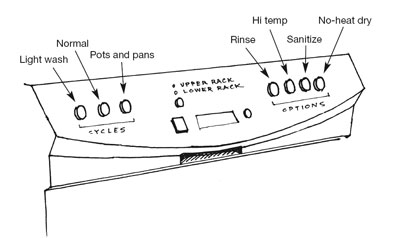Buying a New Dishwasher
There are a couple of quick ways to identify the most efficient dishwashers in the store or online. ENERGY STAR qualifies a broad range of products. Today’s ENERGY STAR dishwashers use 5-40% less energy per cycle than comparable non-ENERGY STAR models. For more information, look for the yellow EnergyGuide label for estimated energy use and a comparison to other models on the market. Although more energy-efficient models tend to use less water, there are variations in water use among ENERGY STAR models — some use half the water of others, saving hundreds of gallons of water each year. To find the most water-efficient models, look at the full ENERGY STAR product list, check the manufacturer’s literature, or contact your local water utility. In some states, electric and water utilities offer rebates for the purchase of models that are exceptionally efficient.
Keep in mind these important features affecting the energy and water use of dishwashers when shopping for a new model.
Energy-Saving Wash Cycles
Most dishwashers have several different wash cycle selections. If a load of dishes is only lightly soiled, a “light wash” cycle will save energy by using less water and operating for a shorter period of time. For example, the same dishwasher may use 3 gallons for a light/china cycle, 5 gallons for a normal wash cycle, and 8 gallons for the pots/pans cycle. Look at the manufacturer’s literature for total water use with different cycles.
Soil Sensors vs. Standard Models
Many of the dishwashers on the market today use “soil sensor” technology to automatically adjust water use depending on how dirty the dishes are in each load. The data presented on updated EnergyGuide labels allows for more accurate comparisons among models with and without soil sensors. Highly efficient models of both types are available.
Energy-Saving “No-Heat” Dry
An electric heating element is generally used to dry dishes at the end of the final rinse cycle, consuming about 7% of dishwasher energy use. Most new dishwashers offer an energy-saving no-heat drying feature. At the end of the rinse cycle, if the feature is selected, room air is circulated through the dishwasher by fans, rather than using an electric heating element to bake the dishes dry.
Compact vs. Standard Capacity
Be aware that there are two dishwasher classifications: compact capacity and standard capacity. Compact models will use less energy, but they also hold fewer dishes. Compact models are usually 18 inches wide, compared to the 24-inch width of most standard capacity models. According to the U.S. Federal Trade Commission, to be considered standard capacity, a dishwasher must be able to hold at least eight place settings of dishes. Some of the most efficient models are only 18 inches wide, yet they can accommodate eight full place settings of dishes, thanks to creative design of the dish racks. Larger models designed to accommodate up to 12 place settings are increasingly available and can save time and energy if you routinely have large loads. Just remember to wait for a full load before running the dishwasher. A compact dishwasher may actually result in more energy use if you have to run it more frequently. Another option is the “dish drawer” type of washer that allows you to wash either each drawer separately or wash a full load.
Ready to Buy? Check out the Enervee Marketplace
ACEEE’s partner, Enervee, makes it simple to find the best deals from your favorite retailers on the most energy efficient dishwashers that meet your needs.
Installing a Dishwasher
When you install a dishwasher, try to position it away from the refrigerator.
The dishwasher produces heat and will increase the energy consumption of your refrigerator. If it is a built-in dishwasher, you might be able to add extra insulation to the top, sides, and back when it’s installed (check with the dealer first). This will both save energy and reduce noise levels. Use unfaced fiberglass batts.


